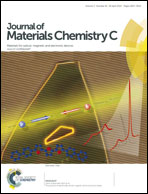Novel up-conversion luminescent rare-earth-doped organic resins for cost-effective applications in 3D photonic devices†
Abstract
Up-conversion luminescent materials have emerged recently for the improvement of the photocatalytic activity of semiconductor electrodes, such as TiO2 and Fe2O3, used for the sustainable production of hydrogen via water-splitting. Here we present novel up-conversion luminescent organic resins doped with heavy rare-earth ions, which are used as constructive elements in the 3D technique, that open a fully unexplored path for the development of cost-effective, room-temperature and endlessly shaped 3D photonic structures, avoiding the technical difficulties of glass melting or crystal growth when used as rare-earth hosts. Moreover, these synthesized resins also present outstanding UV-Vis up-conversion luminescence of Er3+ and Tm3+ ions sensitized by Yb3+ ions under near-infrared excitation at 980 nm, and have been extensively analyzed as a function of the doping concentration. Furthermore, the increase in the Yb3+ to Er3+ and Tm3+ ratio results in a notable enhancement of the UV-blue high energetic emission bands, allowing the tailoring of the overall up-conversion luminescence to match the different band-gaps of selected photocatalysts.


 Please wait while we load your content...
Please wait while we load your content...